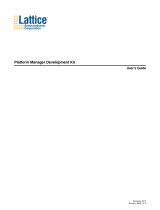
December 22, 2022
evk0006.2 JCJH
TDINV3000W050B User Guide
Dead time control
The required form of the gate-drive signals is shown in Figure 3. The times marked A are the dead times when neither transistor
is driven on. The dead time must be greater than zero to avoid shoot-through currents. The Si82xx gate drive chip ensures a
minimum dead time based on the value of resistor R4 and R5, connected to the AC input. The dead time in ns is equal to the
resistance in kΩ x 1, so the default value of 150k corresponds to 150ns. This will add to any dead time already present in the
input signals. The on-board pulse generator circuit; for example, creates dead times of about 100ns (see Figure 6). The resulting
dead time at the gate pins of Q1 and Q2 is about 100ns. Either shorting or removing R4, R5 will reduce the dead time to 60ns.
Output filter
A simple filter on the output (L1, L2) attenuates the switching frequency, producing a clean sinusoidal waveform for output
connections in terminals J4 and J5. The filter inductors and capacitors used on the demo board were chosen to provide the
optional combination of benefits: low loss, good attenuation of the switching frequency, and small size. Consult the schematic
and/or bill of materials to verify values; but in general, the cutoff frequency will be around 5kHz - 10kHz to accommodate 100Hz
switching. The inductors have powder cores with relatively low permeability (60-90) and soft saturation characteristics. The
inductors and/or capacitors can be changed to evaluate different filter designs.
Current sensing
Hall sensors U5 and U6 provide linear current feedback to the microcontroller. These signals are used to control output power
flow, to protect against over current. Note that these are placed at an intermediate point of the output filter. Refer to the bill of
materials on page 7 to confirm the sensor part numbers, but typical would be the MPS MCS1802GS-40-Psensor, which has a
±40A range (100mV/A). These parts are pin-compatible with a ±5A and ±30A versions of MCS1802GS, should lower ranges be
desired. Note also that resistor dividers scale the 5V outputs for the 3V range of the A/D.
Communication
Communication between the microcontroller and a computer is accomplished with a mini USB cable to a JTAG microcontroller
interface.
Control card
The microcontroller resides on a removable card, which inserts in a Samtec 60 pin socket on the inverter PCB. The socket can
accept many of the DSPIC series control cards from Microchip. The Microchip DSPIC33 PIM card supplied with the kit provides
capability to experiment with a wide variety of modulation and control algorithms. It comes loaded with firmware to allow
immediate, out-of-the-box, operation. Should the user wish to use an alternative microcontroller family, an appropriate control
card can be designed to insert into the Samtec 60 pin socket.
Heatsink
The two TO-247 GaN FETs on each half-bridge are mounted on a common heatsink. The heatsink is adequate for 3000W
operation with forced air flow. Even higher efficiency at high power may be achieved by minimizing the temperature rise. This
may be accomplished with stronger airflow. Alternately the heatsinks could be replaced with larger and more effective ones.
















